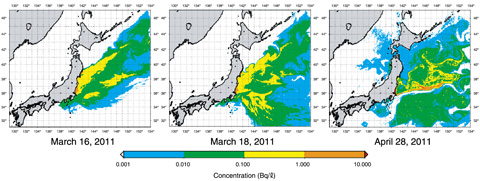
Fig.1-6 Concentration of Cs-137 at the sea surface predicted using a simulation assuming direct ocean release and atmospheric deposition
A large amount of radionuclides was discharged into the atmosphere by the TEPCO’s Fukushima Daiichi NPS (1F) accident. Many of them were transferred toward the east and deposited into the ocean. Moreover, some water used for cooling of the damaged nuclear reactors leaked from the plant and flowed into the ocean. It is important to understand the actual conditions of the release of radionuclides into the ocean in order to assess the influence of the accident on the marine environment. Therefore, an ocean diffusion experiment based on a numerical simulation was performed using a general ocean circulation model developed at Kyoto University and a diffusion model for radionuclides in the ocean (SEA-GEARN) developed by JAEA.
To perform a radionuclide migration simulation in the ocean, it is necessary to predict the ocean currents. In this study, the accuracy of ocean current data was improved by applying the four-dimensional variation method, which is a highly efficient data assimilation technique that assimilates observational data to a numerical model.
Determining the amount of released radionuclides presented the most difficulty, because information about the source term, e.g., the released radionuclides, amounts, and duration, which is essential for the numerical experiments, was not available. Thus, the source term for the radionuclides released directly into the ocean from 1F was estimated using the concentrations of radioactive materials in the ocean reported by TEPCO. Regarding the atmospheric deposition of radionuclides, the results calculated with WSPEEDI were used.
Fig.1-6 shows the concentration of Cs-137 at the sea surface, as determined using the simulation. A peak atmospheric release occurred on March 15. Cs-137 was deposited on the sea surface along the Fukushima and Miyagi prefectures and offshore of the area northeast of Miyagi prefecture. The concentration of the radionuclides deposited on the sea was diluted by the Oyasio water and then they moved southward. The radionuclides that arrived in the Kuroshio region were quickly carried eastward by the Kuroshio extension, whereas the radionuclides separated from the Kuroshio extension showed a tendency to stagnate in that region for a while.
A numerical simulation of the long-term dispersal of radionuclides in the Pacific Ocean will be performed in order to assess their impact on the marine environment.